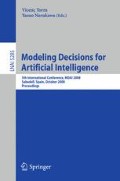Abstract
In this paper, a new method for secure remote biometric authentication preventing the vulnerability of compromised biometrics is presented. The idea is based on a public-key cryptographical protocol, referred as Zero-knowledge Proof, which allows a user to prove that she has surely a valid biometric data without revealing the data. Hence, the scheme is free from the risk of disclosure of biometric data. Even if a malicious administrator has a privilege access to the private database, it is infeasible for him to learn the private template. This paper studies two well-known definitions, the cosine correlation and the Euclidean distance as similarities of given two feature vectors. Both similarities are defined with some multiplications and additions, which can be performed in privacy-preserving way because of the useful property of public-key commitment scheme, additive homomorphism. The estimation based on the experimental implementation shows that the private Euclidean distance scheme archives better accuracy in terms of false acceptance and rejection than the private cosine coloration scheme, but it requires about 5/2 n ℓ overhead to evaluate n-dimension feature vectors consisting of ℓ-bit integers.
Access this chapter
Tax calculation will be finalised at checkout
Purchases are for personal use only
Preview
Unable to display preview. Download preview PDF.
References
Chan, A., Frankel, Y., Tsiounis, Y.: Easy Come – Easy Go Divisible Cash. In: Price, W.L., Chaum, D. (eds.) EUROCRYPT 1987. LNCS, vol. 304, pp. 127–141. Springer, Heidelberg (1988)
Fujisaki, E., Okamoto, T.: Statistical Zero Knowledge Protocols to Prove Modular Polynomial Relations. In: Kaliski Jr., B.S. (ed.) CRYPTO 1997. LNCS, vol. 1294, pp. 16–30. Springer, Heidelberg (1997)
Nist Fingerprint Image Software 2 (NFIS2), http://fingerprint.nist.gov/NFIS/
Ratha, N.K., Connell, J.H., Bolle, R.M.: Enhancing security and privacy in biometrics-based authentication systems. IBM Systems Journal 40(3) (2001)
Jeong, M.Y.: Changeable Biometrics for Appearance Based Face Recognition. In: Proc. of Biometric Symposium, Biometric Consortium Conference, Baltimore (September 2006)
Juels, A., Sudan, M.: A Fuzzy Vault Scheme. In: Lapidoth, A., Teletar, E. (eds.) Proc. IEEE Int’l. Symp. Information Theory, p. 408 (2002)
Clancy, T.C., Kiyavash, N.: Secure Smartcard–Based Fingerprint Authentication. In: Proc. ACM SIGMM 2003 Multim. Biom. Met. App., pp. 45–52 (2003)
Juels, A., Wattenberg, M.: A Fuzzy Commitment Scheme. In: Tsudik, G. (ed.) Sixth ACM Conf. Computer and Comm. Security, pp. 28–36 (1999)
Boudot, F.: Efficient proofs that a committed number lies in an interval. In: Preneel, B. (ed.) EUROCRYPT 2000. LNCS, vol. 1807, pp. 431–444. Springer, Heidelberg (2000)
Maltoni, D., Maio, D., Jain, A.K., Prabhakar, S.: Handbook of Fingerprint Recognition. Springer Science + Business Media, Heidelberg (2003)
Cramer, R., Damgård, I., Schoenmakers, B.: Proofs of partial knowledge and simplified design of witness hiding protocols. In: Desmedt, Y.G. (ed.) CRYPTO 1994. LNCS, vol. 839, pp. 174–187. Springer, Heidelberg (1994)
Uludag, U., Jain, A.K.: Fuzzy Fingerprint Vault. In: Proc. Workshop: Biometrics: Challenges Arising from Theory to Practice, pp. 13–16 (2004)
Author information
Authors and Affiliations
Editor information
Editors and Affiliations
Rights and permissions
Copyright information
© 2008 Springer-Verlag Berlin Heidelberg
About this paper
Cite this paper
Kikuchi, H., Nagai, K., Ogata, W., Nishigaki, M. (2008). Privacy-Preserving Similarity Evaluation and Application to Remote Biometrics Authentication . In: Torra, V., Narukawa, Y. (eds) Modeling Decisions for Artificial Intelligence. MDAI 2008. Lecture Notes in Computer Science(), vol 5285. Springer, Berlin, Heidelberg. https://doi.org/10.1007/978-3-540-88269-5_2
Download citation
DOI: https://doi.org/10.1007/978-3-540-88269-5_2
Publisher Name: Springer, Berlin, Heidelberg
Print ISBN: 978-3-540-88268-8
Online ISBN: 978-3-540-88269-5
eBook Packages: Computer ScienceComputer Science (R0)

